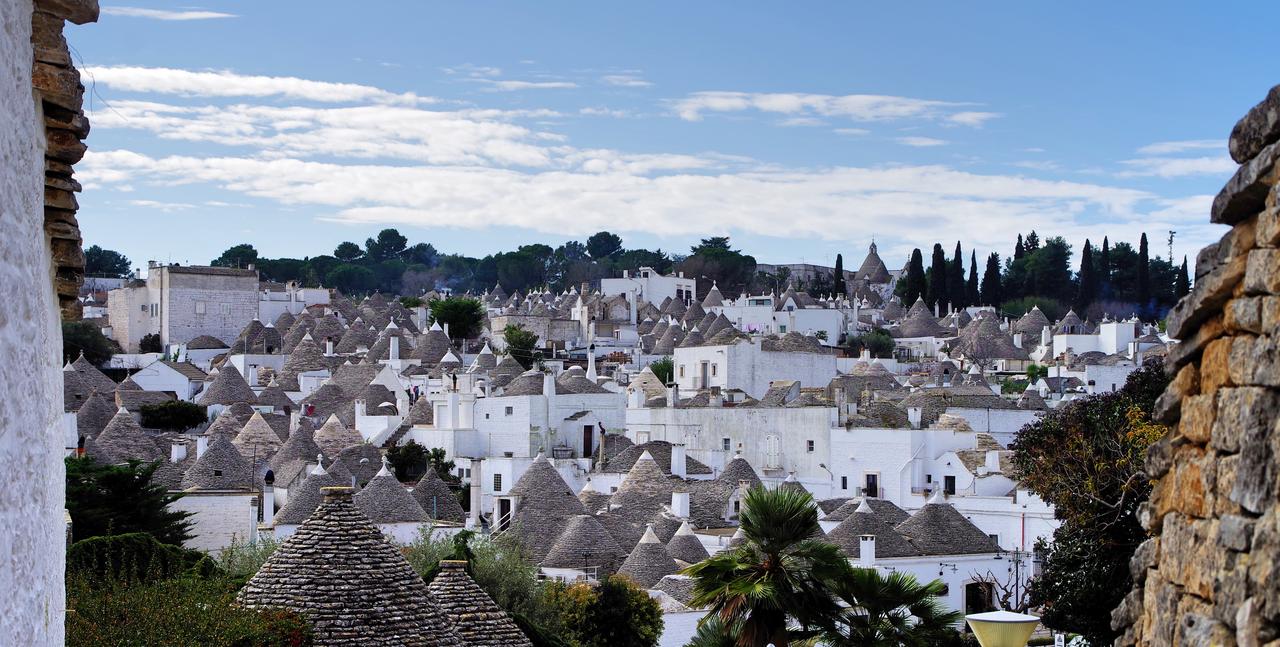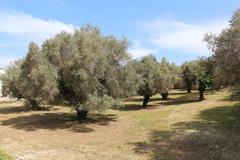
Comprehensive Guide to Visiting Alberobello, Metropolitan City of Bari, Italy
Date: 13/08/2024
Captivating Introduction
Welcome to Alberobello: A Journey into a Fairytale Village
Imagine stepping into a storybook where every house has a conical hat, and the streets whisper tales of ancient times. Welcome to Alberobello, a magical town nestled in the heart of Puglia, Italy. Known for its unique trulli houses, Alberobello transports visitors into a world that feels both timeless and enchanting. These stone huts, with their whimsical architecture and rich history, make Alberobello a must-visit destination for those seeking a blend of culture, history, and architectural marvels.
The trulli, which date back to the 14th century, are not just buildings but symbols of the ingenuity and resilience of the local population. Constructed without mortar to evade taxes, these structures have evolved from simple agricultural shelters to elaborate residential homes (Alberobello.com). Walking through the streets of Alberobello, you’ll find yourself surrounded by these ancient stone dwellings, each with its own unique charm and story.
As you explore Alberobello, you’ll discover districts like Rione Monti, bustling with shops and restaurants, and Aia Piccola, a serene retreat where trulli continue to serve as cozy homes (Nomads Travel Guide). The town’s rich cultural heritage is further highlighted by attractions such as the Trullo Sovrano, the largest trullo, and the Church of Saint Anthony, a trullo-style church that stands as a blend of religious and local architectural styles (Italian Trip Abroad).
Whether you’re tasting the local cuisine, participating in olive oil tastings, or enjoying traditional music performances, Alberobello offers an immersive experience that captivates all your senses. Ready to uncover the secrets and stories of this enchanting town? Let’s dive into the magic of Alberobello.
Table of Contents
- Historical Background and Significance of the Trulli
- Main Attractions in Alberobello
- Rione Monti: The Beating Heart of Alberobello
- Aia Piccola: A Tranquil Retreat
- Trullo Sovrano: A Majestic Marvel
- Church of Saint Anthony: A Spiritual Trullo
- Casa d’Amore: A Symbol of Change
- Belvedere Santa Lucia: A View to Remember
- Trullo Siamese: A Tale of Two Brothers
- Museo del Territorio: A Journey Through Time
- Olive Oil Tasting: A Flavorful Experience
- Traditional Music Performances: A Cultural Feast
- Guided Tours: Explore with an Expert
- Practical Tips for Visitors
Historical Background and Significance of the Trulli
Step into a World of Stone Magic
Ever wondered what it feels like to walk through a village straight out of a fairytale? Welcome to Alberobello, where the whimsical trulli with their conical roofs transport you to a realm of architectural wonders. These stone huts, dating back to the 14th century, hold secrets that have been whispered through the ages, crafted by the hands of ingenious locals using nothing but limestone and a sprinkle of magic.
Origins and Evolution
The origins of the trulli, those iconic dry-stone huts with captivating conical roofs, are shrouded in mystery. Believed to date back to the 14th century, with the oldest surviving examples from the 16th century, these structures were initially constructed as temporary shelters for agricultural workers. Imagine the scene: the sun setting over the karst region of Puglia, particularly the Murgia of Bari, and farmers using the abundant limestone to build these enchanting structures (Alberobello.com).
Architectural Features
Trulli are not just buildings; they are stories etched in stone. Characterized by their distinctive conical roofs often adorned with symbols painted in white, these symbols—be they Christian, Jewish, or Pagan—ward off bad luck. The construction technique, using dry stone without any mortar, harks back to prehistoric times. This technique made the structures easy to dismantle, perfect for evading taxes, as buildings without mortar weren’t considered permanent and thus not taxable (World Heritage Site). Can you believe it? Tax evasion with style!
Development into Villages
From simple agricultural shelters, the trulli evolved into complex residential structures over the centuries. By the 18th and 19th centuries, small villages of trulli, known as ‘courts,’ began to form in the countryside. Imagine these courts with shared amenities like water tanks, ovens, and oil mills. In Alberobello, these courts gradually merged, forming a single inhabited center entirely built with trulli (Alberobello.com). It’s like a stone tapestry woven through time.
UNESCO World Heritage Site
On December 7, 1996, Alberobello’s trulli were designated as a UNESCO World Heritage Site, praised as ‘an exceptional example of vernacular architecture.’ This recognition specifically includes the Rione Monti and Rione Aia Piccola districts, which have retained their original beauty despite some landscape changes in other parts during the 1960s and 1970s (Alberobello.com). Think of it as a badge of honor for these stone marvels.
Cultural Significance
The trulli of Alberobello are not just architectural marvels; they are a testament to the ingenuity and resilience of the local population. These structures have survived for centuries, adapting from agricultural shelters to permanent homes. The trulli symbolize the Puglia region, representing a unique way of life preserved through generations (World Heritage Site).
Preservation and Tourism
Thanks to UNESCO, Alberobello now attracts hundreds of thousands of visitors each year. The town has managed to balance tourism with preservation, ensuring the trulli remain in good condition. Some trulli have even been converted into accommodations, offering tourists the opportunity to stay overnight and immerse themselves in local culture (Voyage Tips). Imagine waking up in a real-life fairytale!
Modern-Day Relevance
Today, the trulli continue to be a focal point of cultural and historical interest. Alberobello embraces its heritage with initiatives aimed at preserving the trulli and promoting their significance. The local community plays an active role in maintaining these structures, ensuring they remain a living part of the town’s heritage rather than mere historical artifacts (Italia Like a Local).
Visitor Experience
Visitors to Alberobello can explore the trulli through guided tours, gaining in-depth insights into their history and construction techniques. The town offers various cultural experiences, including local cuisine and traditional crafts, allowing tourists to fully appreciate the region’s rich heritage. Key attractions include the Santa Lucia Viewpoint, offering panoramic views of the trulli, and the Trullo Sovrano, the largest trullo in Alberobello, now a museum (The World Was Here First).
Nearby Attractions
Beyond the trulli, explore nearby towns like Locorotondo and Cisternino, which also feature trulli and offer a more authentic, less commercialized experience. Other notable attractions include the Castellana Caves, less than 20 minutes by car from Alberobello, and the ‘White City’ of Ostuni, known for its whitewashed facades and stunning views of the Itria Valley (Voyage Tips).
Practical Information
Alberobello is easily accessible by car from major cities like Bari and Brindisi, both with international airports. The town is compact and walkable, making it easy to explore its quaint streets and unique sights. For those staying overnight, accommodations range from traditional trulli to modern hotels, catering to various budgets and preferences (Italia Like a Local).
Main Attractions in Alberobello
Rione Monti: The Beating Heart of Alberobello
Imagine wandering through a labyrinth of over 1,000 trulli, each with its whimsical conical roof. That’s Rione Monti for you—a bustling district where trulli have transformed into charming shops, inviting restaurants, and intriguing museums. Here, you can find local crafts, textiles, and trullo-themed memorabilia. The lively atmosphere makes Rione Monti a must-visit for anyone wanting to experience the commercial pulse of Alberobello (Nomads Travel Guide).
Aia Piccola: A Tranquil Retreat
Step into Aia Piccola, the serene side of Alberobello, where about 400 trulli still serve as cozy homes. This district offers a peaceful escape from tourist crowds and a glimpse into the everyday lives of locals. Stroll through the quiet streets, marvel at the traditional architecture, and soak in the simplicity of life in this historic town (Nomads Travel Guide).
Trullo Sovrano: A Majestic Marvel
Meet the Trullo Sovrano, the largest trullo in Alberobello and a true architectural masterpiece. Now a museum, this two-story marvel showcases the ingenuity of dry-stone construction. Inside, explore exhibits detailing trulli history and construction techniques. Located behind the Church of Santi Medici Cosma e Damiano, the Trullo Sovrano offers a fascinating peek into the past for a small entrance fee (Italian Trip Abroad).
Church of Saint Anthony: A Spiritual Trullo
Perched atop Rione Monti, the Church of Saint Anthony stands out with its trullo-style architecture. Built in 1927, this church blends religious and local architectural styles with its conical roof. Inside, the simple yet elegant interior provides a serene space for reflection. Don’t miss the panoramic views of the surrounding trulli districts from this unique landmark (Nomads Travel Guide).
Casa d’Amore: A Symbol of Change
Casa d’Amore, built in 1797 by Francesco d’Amore, marks a pivotal moment in Alberobello’s history. As the first mortar-constructed building, it symbolizes the end of feudal tyranny. Declared a national monument in 1930, Casa d’Amore is a must-visit for history buffs and those interested in architectural evolution (Go World Travel).
Belvedere Santa Lucia: A View to Remember
For a breathtaking view of Alberobello, head to Belvedere Santa Lucia, next to the Church of Saint Lucia. This viewpoint offers a stunning panorama of trulli rooftops, especially magical at sunset. It’s the perfect spot for photography enthusiasts looking to capture the town’s unique beauty (Andoreia).
Trullo Siamese: A Tale of Two Brothers
The Trullo Siamese is one of Alberobello’s most unique trulli, with its distinctive double-cone roof. According to local legend, it was built for two brothers who fell in love with the same woman. Its design reflects their division, with separate entrances and living spaces. Discovering the Trullo Siamese is like stepping into a local fairy tale (Italian Trip Abroad).
Museo del Territorio: A Journey Through Time
The Museo del Territorio offers an immersive look into the region’s history and culture. Housed in interconnected trulli, the museum showcases local traditions, crafts, and the history of the trulli. Learn about agricultural practices, folklore, and daily life in the Itria Valley, and enjoy temporary exhibitions and cultural events (Beautiful Puglia).
Olive Oil Tasting: A Flavorful Experience
In the heart of Puglia, renowned for its high-quality olive oil, participate in olive oil tasting tours. Sample various types, learn about production processes, and visit local olive groves and mills. It’s a delightful way to savor the region’s flavors and appreciate the craftsmanship behind this essential product (Italy Unseen).
Traditional Music Performances: A Cultural Feast
Immerse yourself in local culture with traditional music performances in Alberobello. Throughout the year, the town hosts events and festivals featuring folk music and dance. These performances, often in town squares or trulli, create a magical atmosphere and offer a rich auditory experience (Italy Unseen).
Guided Tours: Explore with an Expert
For a structured exploration, opt for guided tours available on foot, by Segway, e-bike, tuk-tuk, or golf cart. These tours often include visits to local homes, olive oil tastings, and cooking classes. A guided tour ensures you don’t miss key attractions and gain valuable insights from knowledgeable guides (Earth Trekkers).
Practical Tips for Visitors
- Best Time to Visit: Spring and fall offer pleasant weather and smaller crowds. Summer can be scorching, so pack accordingly (Andoreia).
- Duration of Visit: While a day is enough to see the highlights, two days allow for deeper exploration of trulli houses and local history (Italy Unseen).
- Avoiding Crowds: Visit in the late afternoon or shoulder seasons. Staying overnight provides a more peaceful experience as many tourists leave by evening (The Geographical Cure).
Unlock more secrets and stories of Alberobello with Audiala, the tour guide app that offers beautifully crafted, concise yet deep audio guides. Download Audiala before your visit to enhance your exploration experience and uncover the magic of this enchanting town.
Conclusion
In the end, Alberobello is not just a destination; it’s a journey through time. This enchanting town, with its iconic trulli, offers a unique blend of history, culture, and architectural wonder. From the bustling streets of Rione Monti to the tranquil retreat of Aia Piccola, every corner of Alberobello invites you to explore and discover its rich heritage and vibrant local life (Nomads Travel Guide).
Visiting Alberobello is like stepping into a fairytale. The trulli, with their charming conical roofs, stand as a testament to the ingenuity and resilience of the local population. These stone huts, recognized as a UNESCO World Heritage Site, continue to captivate visitors with their unique charm and historical significance (World Heritage Site).
Whether you’re exploring the largest trullo, Trullo Sovrano, or enjoying panoramic views from Belvedere Santa Lucia, Alberobello offers countless opportunities to immerse yourself in its magical atmosphere (Andoreia). The town’s commitment to preserving its heritage while embracing modern tourism ensures that the trulli remain a living part of the community, not just historical artifacts (Italia Like a Local).
Ready to embark on your own adventure? Download Audiala, the ultimate tour guide app, and unlock the secrets of Alberobello. With beautifully crafted audio guides, expert insights, and hidden gems, Audiala is your perfect companion for an unforgettable journey through this enchanting town.
References
- Alberobello.com (n.d.). Culture and Traditions - Alberobello UNESCO. Retrieved from https://www.alberobello.com/en/culture-and-traditions/alberobello-unesco
- World Heritage Site (n.d.). The Trulli of Alberobello. Retrieved from https://www.worldheritagesite.org/list/The+trulli+of+Alberobello
- Voyage Tips (n.d.). Alberobello. Retrieved from https://www.voyagetips.com/en/alberobello
- Italia Like a Local (n.d.). Best Things to Do in Alberobello. Retrieved from https://www.italialikealocal.com/best-things-to-do-in-alberobello
- The World Was Here First (n.d.). Alberobello Itinerary. Retrieved from https://www.theworldwasherefirst.com/alberobello-itinerary
- Nomads Travel Guide (n.d.). Alberobello. Retrieved from https://www.nomads-travel-guide.com/city/alberobello
- Italian Trip Abroad (n.d.). Things to Do in Alberobello, Puglia. Retrieved from https://italiantripabroad.it/Blog/things-to-do-in-alberobello-puglia — Go World Travel (n.d.). Things to Do in Alberobello, Puglia, Italy. Retrieved from https://www.goworldtravel.com/things-to-do-in-alberobello-puglia-italy
- Andoreia (n.d.). Alberobello, Italy: Things to Do. Retrieved from https://andoreia.com/alberobello-italy-things-to-do
- Beautiful Puglia (n.d.). Alberobello. Retrieved from https://www.beautifulpuglia.com/alberobello
- Italy Unseen (n.d.). The Ultimate Guide to Alberobello, Puglia. Retrieved from https://italyunseen.com/the-ultimate-guide-to-alberobello-puglia
- Earth Trekkers (n.d.). Best Things to Do in Alberobello. Retrieved from https://www.earthtrekkers.com/best-things-to-do-in-alberobello
- Bari Experience (n.d.). How to Reach Alberobello Starting from Bari by Car, Train, Bus. Retrieved from https://www.bariexperience.com/en/bari-tourist-experiences/how-to-reach-alberobello-starting-from-bari-by-car-train-bus-puglia
- ImaginApulia (n.d.). Alberobello, Puglia Trulli. Retrieved from https://imaginapulia.com/points-of-interest/alberobello-puglia-trulli


